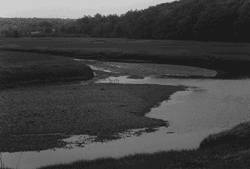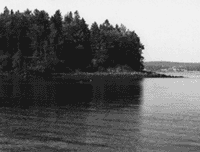Biodiversity in the Gulf, Part 2:
Ecologists urge action to prevent loss
By Suzy Fried, Editor
Editor's note: This is the second of a two-part series on biodiversity. Part
1 appeared in the December 1999 issue of the Gulf of Maine Times. If you
missed that issue, visit www.gulfofmaine.org/
times and click on "Back Issues."
Gulf of Maine - Depletion of fish stocks, exotic species invasions, development, and toxic pollution are decreasing diversity in the Gulf of Maine's ecological systems, ecologists say. This loss of diversity, also known as simplification, reduces a system's ability to carry out essential functions by limiting the numbers of ways in which those functions can occur.
For us, this decline in biodiversity - the diversity of living things - can mean loss of the products and services provided by marine and coastal systems: food, water filtration, and protection against erosion, as well as aesthetic, cultural, and emotional benefits.
Citing a worldwide decline in biodiversity, ecologists say people can and should take action to conserve it, starting in their own households and communities. "Changing our lifestyle so that we don't require so much is the first step," said Sherman Boates, Manager of Nova Scotia's Biodiversity Program. But ecologists also warn that neighborhood, or even regional stewardship, is not enough.
"What I wouldn't want to see happen is people working at a local level thinking that's enough to protect biodiversity," said Inka Milewski, Atlantic Coordinator for World Wildlife Fund - Canada's Marine Protected Areas Program. She and others say that nations have to address biodiversity conservation on a much larger scale.
UN Biodiversity Convention
Both Canada and the US have signed the International Convention on Biodiversity. While Canada has ratified the Convention, making a formal commitment to adhere to it and institutionalizing a national approach to biodiversity, the US has done neither, although the President's Committee of Advisers on Science and Technology in 1998 called for more study of and focus on biodiversity. US officials also say that state and federal governments are attempting to weave biodiversity conservation into their marine and coastal programs.
Canada's Biodiversity Convention Office, an office of the federal agency, Environment Canada, has established working groups of provincial and federal representatives who meet regularly with some private-sector organizations to develop the nation-wide biodiversity policies that provincial government departments incorporate into their work.
"So many of the issues that are important to biodiversity are things that we were doing independent of the biodiversity convention," said Parker Gray, Senior Policy Advisor for the New Brunswick Department of Environment, though he added that the convention "has lent some visibility" to those efforts.

Puffins on Machias Seal Island (click for larger version)
Photo: Joe Kennedy
However, the Biodiversity Board of Canada, an independent board of scientists, recently expressed concern about a shortage of investment in biodiversity science. The board recommended in a January 19, 2000 report that Canada develop a biodiversity science plan to meet its commitments under the Biodiversity Convention.
Another important tool that Canada has lacked in biodiversity conservation, however, is federal endangered species legislation. A Species At Risk Act (SARA) has been proposed in the federal legislature and is awaiting action, while the US enacted its Endangered Species Act in 1973. But the US-based National Wildlife Federation (NWF) warns that this sort of legislation alone is not enough to protect species. NWF notes that by definition, the legislation authorizes intervention only when a species is in danger of extinction, which may be too late.
Government action
On the federal level, the US National Marine Fisheries Service (NMFS), under the National Oceanic and Atmospheric Administration (NOAA), and the Canadian Department of Fisheries and Oceans (DFO) assert that they are working to incorporate an "ecosystem approach" that considers the interrelationships of species in place of older management methods that consider species separately from one another. But the transition is taking place slowly, especially in the US, which lacks Canada's national mandate to push for biodiversity conservation.
NOAA has not yet made the ecosystem approach its standard, acknowledged Roger Griffis, a member of NOAA's Standing Committee on Biodiversity and Ecosystem Management at the agency's Office of Policy and Strategic Planning. But, he said, the agency has begun to implement "broader approaches to management of marine fisheries and coastal zones," including incorporating protection for Essential Fish Habitat in fishery management plans, and discussing how fishery reserves or protected areas might replenish and protect depleted stocks and their habitat.

Tidal Marsh in Nova Scotia (click for larger version)
Photo: Suzy Fried/Gulf of Maine Times
"NOAA has tried several times in the past five years to specifically ask for new funding to expand biodiversity assessment, and to be quite honest they haven't done very well," said Griffis. "People don't always see the connection between the value of being able to understand and track changes in biodiversity with being able to make better fishery management decisions."
Provincial departments in New Brunswick and Nova Scotia say they have incorporated biodiversity conservation into their traditional areas of responsibility for years, and sources in Maine, New Hampshire, and Massachusetts say their state governments are increasingly doing so. In New Hampshire, however, it often "takes a back seat to development and transportation considerations" in the opinion of David VanLuven, Coordinator of that state's Natural Heritage Program, which is part of a network that compiles data on biodiversity in the western hemisphere.

Blue mussels (click for larger version)
Photo: NH Department of Environmental Services
In Massachusetts, an extensive biodiversity program is emerging from the Executive Office of Environmental Affairs, according to Sharon McGregor, Assistant Secretary for Biological Conservation and Ecosystem Protection.
One component of the program, a Citizens' Guide to Protecting Biological Diversity and
Ecosystems, is to be distributed to communities this spring. It will encourage people to explore their own neighborhood ecosystems, and record their findings in local habitat registries being created in each city and town, McGregor said. "Our thrust is to build a constituency for biodiversity conservation, which we don't have in the public right now."
Making the connection
While government agencies in the Gulf are working on biodiversity issues, the nature of government structures has been to divide and separate responsibilities, budgets, and staff, and several US and Canadian sources noted that this has complicated efforts to integrate programs among departments and agencies. "Everyone wants to break things down into little pieces, but people have such difficulty in trying to understand the interconnections and interrelations of everything," observed Gray.
Even if government agencies have trouble merging their own programs, however, they are finding ways to work with other organizations to address biodiversity
in the Gulf of Maine.
The Huntsman Marine Science Center, a nonprofit research and education organization in St. Andrews, New Brunswick, is working with Environment Canada's Ecological Monitoring Assessment Network to develop protocols for monitoring marine biodiversity, according to Gerhard Pohle, Senior Applied Project Scientist at the science center.
The Island Institute in Rockland, Maine, has collaborated with NMFS and with Maine's Department of Marine Resources on several biodiversity-related projects that evolved from discussions with fishermen and others who rely on fishery resources, according to Bill MacDonald, Marine Resources Director for the Institute. Fishermen participate in those projects by collecting information on herring, lobster, and other species, and by allowing researchers aboard their vessels.
In 1998, Griffis noted, the Gulf of Maine Council worked with NOAA, Woods Hole Oceanographic Institute, and other partners to develop an inventory and maps of coastal and marine protected areas, conservation zones, and fishery reserves in the Gulf of Maine. He described the effort as an attempt to design a network of reserves and fishery replenishment zones that would conserve and renew biodiversity in the region.
Call for more conservation
Milewski asserted that federal, provincial, and state governments must provide more incentives to industry and more assistance to municipalities in cleaning up pollution and undertaking other measures to preserve aquatic ecosystems. The Conservation Council of New Brunswick is lobbying for Canadian/US coordination on the management of toxic chemicals, nutrients, habitat protection, and biodiversity conservation.

The St. Croix River, New Brunswick (click for larger image)
Photo: Suzy Fried/Gulf of Maine Times
Any new restrictions on commercial uses of the Gulf are bound to meet with resistance. Following a series of recent fishery closures intended to address the Gulf's collapsing groundfish stocks, many fishermen consider themselves an endangered species. But ecologists say conservation will ultimately benefit all who rely on the presence of diversity in the Gulf - including the fishing industry - by protecting the ecosystems that produce fish and other so-called products and services.
"Over the last 200 years in North America, our use of the ocean has reduced its quality," said Milewski. "I'm not prepared to accept that and I don't think people are prepared to accept that loss of quality. We need to stop it and try to reverse it. We need to do that while being sensitive to the people who are currently using it. Nobody wants to be displaced from their job, nobody wants to lose their livelihood, but maybe we all have to pay a little bit of a price to try to improve things."
|

